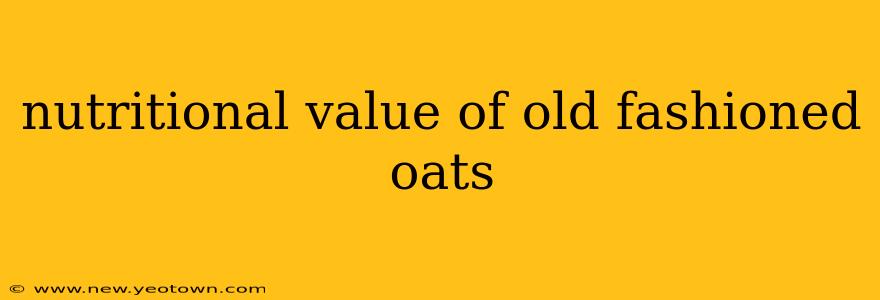Old-fashioned oats. Just the name conjures images of warm, comforting bowls of porridge on chilly mornings. But beyond their delicious simplicity lies a nutritional powerhouse packed with benefits that extend far beyond a satisfying breakfast. Let's delve into the wholesome goodness of these humble grains and explore why they deserve a prominent place in your diet.
My grandmother, a woman who knew the value of a hearty, wholesome meal, always kept a canister of old-fashioned oats on her pantry shelf. She'd tell me stories of their versatility – from creamy porridge to hearty oatcakes – while subtly imparting the wisdom of their nutritional benefits. It's this legacy, combined with modern nutritional science, that I want to share with you today.
What Makes Old-Fashioned Oats So Nutritious?
Old-fashioned oats, unlike their quicker-cooking cousins, retain their bran and germ. This is crucial because these parts of the oat kernel are where the majority of the fiber, vitamins, and minerals reside. This intact structure is what gives old-fashioned oats their superior nutritional profile compared to instant oats.
Think of it like this: The bran is like the protective outer shell, rich in fiber, while the germ is the heart of the oat, bursting with vitamins and minerals. Processing instant oats often removes or significantly reduces these vital components, leaving a less nutrient-dense product.
Are Old-Fashioned Oats Good for Weight Loss?
This is a question many people ask. The answer is a resounding, "Yes, but..." Old-fashioned oats are rich in soluble fiber, a type of fiber that absorbs water and forms a gel-like substance in your digestive tract. This gel slows down digestion, leading to a feeling of fullness and satiety. This helps regulate blood sugar levels, preventing those mid-morning energy crashes that often lead to unhealthy snacking. However, weight loss is a complex process influenced by many factors, including overall diet and exercise. While oats can be a valuable tool in a weight-management strategy, they are not a magic bullet.
What Vitamins and Minerals Are in Old-Fashioned Oats?
Old-fashioned oats are a good source of several essential vitamins and minerals, including:
- Fiber: Both soluble and insoluble fiber are abundant, contributing to digestive health and blood sugar regulation.
- Manganese: Crucial for bone health, wound healing, and metabolism.
- Magnesium: Essential for muscle and nerve function, blood sugar control, and blood pressure regulation.
- Phosphorus: Important for bone health and energy production.
- Selenium: An antioxidant that protects cells from damage.
- Zinc: Supports immune function and wound healing.
- B Vitamins: Important for energy metabolism and nerve function.
How Many Calories Are in Old-Fashioned Oats?
A typical serving (1/2 cup dry) of old-fashioned oats contains approximately 150 calories. However, the addition of toppings like milk, sugar, or fruit will significantly increase the calorie count.
What Are the Health Benefits of Eating Old-Fashioned Oats?
The benefits extend beyond weight management. Regular consumption of old-fashioned oats has been linked to:
- Improved Heart Health: The soluble fiber helps lower LDL ("bad") cholesterol levels.
- Better Blood Sugar Control: The slow release of carbohydrates helps prevent blood sugar spikes.
- Enhanced Digestive Health: The high fiber content promotes regular bowel movements and prevents constipation.
- Increased Satiety: Keeping you feeling full and satisfied for longer periods.
Are Old Fashioned Oats Gluten Free?
No, old-fashioned oats are not naturally gluten-free. While oats themselves are gluten-free, they are often processed in facilities that also handle wheat, barley, and rye, leading to cross-contamination. To ensure you're consuming gluten-free oats, look for certified gluten-free options.
My grandmother's wisdom about the humble oat has been confirmed by decades of research. Old-fashioned oats, with their rich nutritional profile and remarkable health benefits, truly are a staple food deserving of a place in any healthy diet. So, next time you're reaching for breakfast, remember the enduring value of this simple yet powerful grain.

